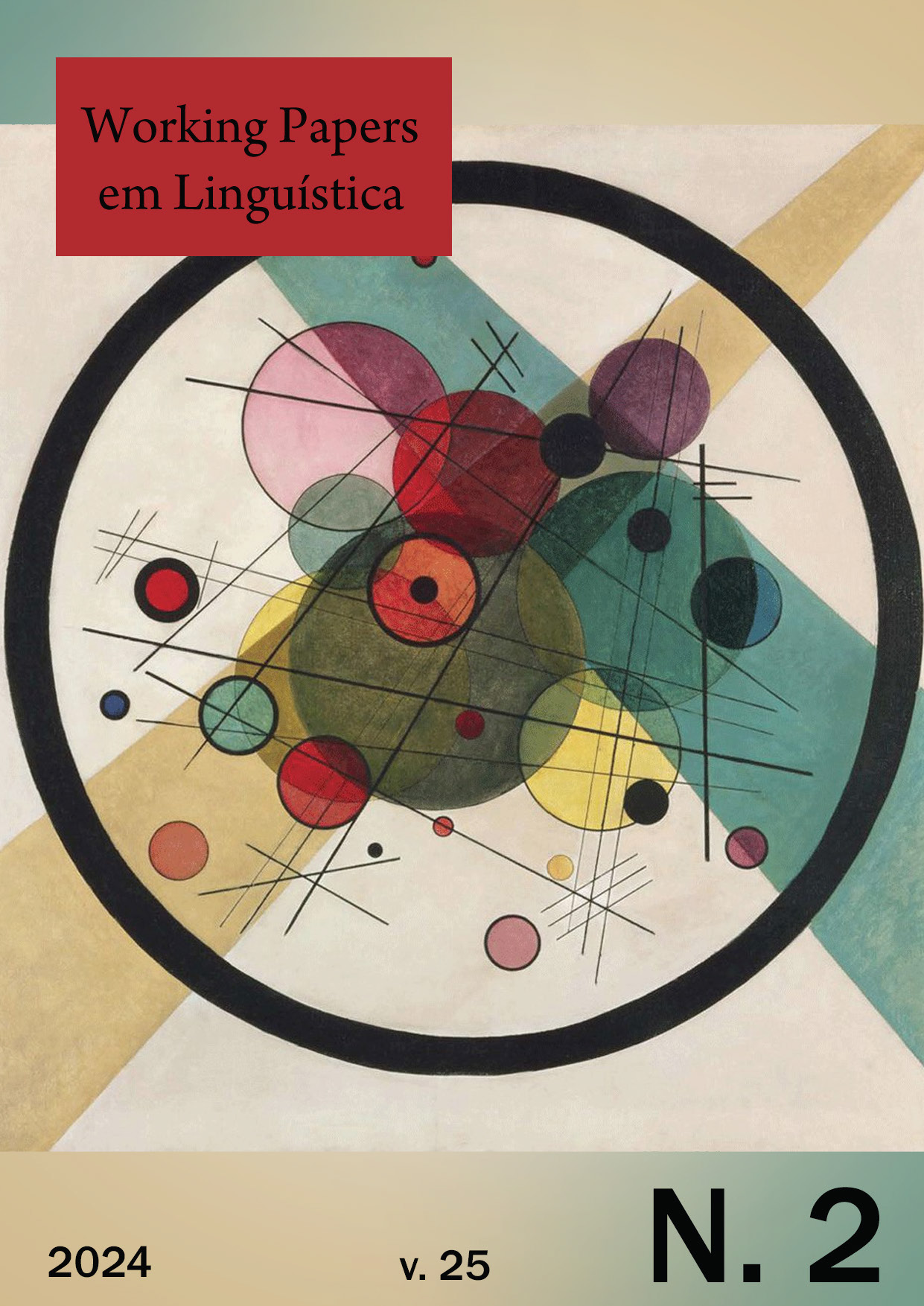Notes on the functional and compositional restrictions of specificational copulatives
DOI:
https://doi.org/10.5007/1984-8420.2024.e100172Keywords:
Copulatives, Copula verb, Specificationals, Predicatives, Informational StructureAbstract
In this article, we analyze sentences mediated by the copula verb ‘ser’ and flanked by two determiner phrases (DPs). We aim to describe copulatives structured in this way and classified as specificational, motivating two of their restrictions: specificationals have restricted use and their first position limits the occurrence of indefinite DPs. In the analysis, we compare specificational copulatives to other copulatives that can be flanked by DPs, the predicatives, in order to have as a parameter a syntactic environment in which the restrictions do not occur. We verify the behavior of the copulatives through coordination and juxtaposition of sentences, adequacy to the structure ‘x says about DP that...’, by the capacity of occurrence of the modifier ‘certo’ in their composition, by question-answer pairs and from the classification of discursive familiarity. We conclude that the value of referentiality/specificity and the ordering of the DPs of specificationals disfavor the use of such copulatives in the topic-comment function. We found that they are marked sentences, specialized for contexts in which they have a presupposition-focus function. As for the composition restriction, we concluded that it arises from the fact that the pre-verbal DP must be composed of old elements in the discourse, which is in line with the finding that this DP conveys information in pragmatic presupposition.
References
AVELAR, J. O. Dinâmicas morfossintáticas com ter, ser, e estar em português brasileiro. 247 p. Dissertação (Mestrado em Linguística) - Instituto de Estudos da Linguagem, Universidade Estadual de Campinas. Campinas, SP, 2004. Disponível em: htp://www.repositorio.unicamp.br/handle/REPOSIP/270357. Acesso em: 3 ago. 2021.
COMOROVSKI, I. Constituent Questions and the Copula of Specifcation. In: VON HEUSINGER, K. (ed.). Existence: Semantics and Syntax. 2008. p. 49–77.
DEN DIKKEN, M. Predicate inversion and minimality. Linguistics in the Netherlands, v. 11, n. 1, pp. 1–12, 1994.
ENÇ, M. Te Semantics of specifcity. Linguistic Inquiry, v. 22, n. 1, p. 1-25, 1991.
HEYCOCK, C. Specifcation, equation, and agreement in copular sentences. Canadian Journal of Linguistics, v. 57, n. 2, p. 209-240, 2012.
HEYCOCK, C. Te internal structure of small clause: new evidence for inversion. Te North East Linguistics Society, v. 25, n. 5, pp. 224-238, 1995. Disponível em: htps://www.researchgate.net/publication/2682822_The_Internal_Structure_of_Small_Clauses_New_Evidence_from_Inversion. Acesso em 20 out. 2019.
HARTMANN, J. M. Focus and prosody in nominal copular clauses. In: FEATHERSTON, S.; HÖRNIG, R.; WIETERSHEIM, S.; WINKLE, S. (EDS). Experiments in Focus: Information Structure and Semantic Processing. Berlin, Boston: De Gruyter, 2020, p. 71-104.
HEGGIE, L. Te Syntax of Copular Structures. Tesis (PhD) - University of Southern California, USC, 1988.
HEYCOCK, C.; KROCH, A. Inversion and equation in copular sentences. ZAS Papers in linguistics, v. 10, p. 71-87, 1998.
HEYCOCK, C; KROCH, A. Pseudoclef connectedness: implications for the LF interface level. Linguistic Inquiry, v. 30, n. 3, p. 365-397, 1999.
HEYCOCK, C.; KROCH, A. Topic, focus, and syntactic representations. In: MIKKELSEN, L.; POTS, C. (Eds). Proceedings of the 21st West Coast Conference on Formal Linguistics, 21, Somerville. Proceedings [...]. Somerville: Cascadilla Press, 2002. p. 101–125.
HIGGINS, F.; R. Te pseudo-clef construction in English. London: Routledge, 1979.
JIMÉNEZ-FERNÁNDEZ, A. L. What information structure tell us about individualstage level predicates. Borealis - An International Journal of Hispanic Linguistics, v. 1, n. 1, p. 1–32, 2012.
JOH, Y. Indefnite subjects in specifcational clauses. Te Journal of Studies in Language, v. 29, n. 4, p. 827-848, 2014.
LAMBRECHT, K. Information structure and sentence form. Cambridge: Cambridge University Press, 1994.
MIKKELSEN, L. Copular clauses: specifcation, predication and equation. Holanda: John Benjamins Publishing, 2005.
MIKKELSEN, L. Copular clauses. In: MAIENBORN, C.; HEUSINGER, K.; PORTNER, P. (Eds.). Semantics: an international handbook of natural language meaning. Berlin: Mouton de Gruyter, 2011. p. 1805-1829. Disponível em: htp://linguistics.berkeley.edu/~mikkelsen/papers/chapter_68.pdf. Acesso em: 20 out. 2019.
MILWAY, D. On some subjects of specifcational copular clauses. 2016. Mais informações em: htps://scholar.google.com/citations?view_op=view_citation&hl=en&user=_D4amuEAAAAJ &citation_for_view=_D4amuEAAAAJ:fQNAKQ3IYiAC.
MORO, A. Te raising of predicates: predicative noun phrases and the theory of clause structure, Cambridge: Cambridge University Press, 1997.
PRINCE, E. Toward a taxonomy of given-new information. In: COLE, P. (Ed.). RadicalPragmatics. New York: Academic Press, 1981. p. 223–256.
RPOSO, E.; URIAGEREK, J. Two types of small clauses (toward a syntax of theme/rheme relations). In: CARDINALETI, A.; GUASTI, M. T. (Eds.). Syntax and semantics: small clauses. San Diego: Academic Press, 1995. p. 179-206.
REINHART, T. Pragmatics and linguistics: an analysis of sentence topics. Philosophica, v. 27, n. 1, p. 53-94, 1981.
Downloads
Published
Issue
Section
License
Copyright (c) 2024 Douglas Alan da Silva

This work is licensed under a Creative Commons Attribution-NonCommercial 4.0 International License.
Copyrights belong to the authors, who allow the Working Papers em Linguística journal to publish their work. Total or partial reproduction requires the Editorial Board's authorization. Names and adresses in this website are exclusively used for the journal's purposes and are not available for other purposes and/or third parties.
![]()
This publication is licensed under Creative Commons - Attribution-NonCommercial - 4.0 International.


